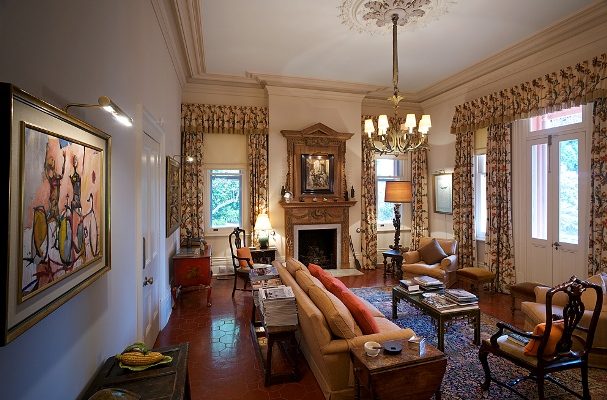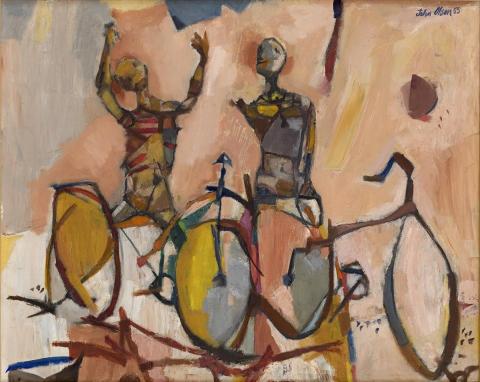THE BICYCLE BOYS REJOICE, 1955
JOHN OLSEN
oil on canvas
60.0 x 75.5 cm
signed and dated upper right: John Olsen 55
bears inscription verso: S.A.
Macquarie Galleries, Sydney
Mrs Brodie Knight, Sydney by 1960
The Estate of the late James O. Fairfax AC, New South Wales
Sydney Painting 1955, Macquarie Galleries for the Victorian Artists Society, Melbourne, 31 May – 11 June 1955; Royal Society of Artists, Adelaide, August 1955, cat. 39
Christmas Selection 2, Macquarie Galleries, Sydney, 7 – 22 December 1955, cat. 15
Galleria Espresso, Sydney, 1956
Contemporary Australian Art, Auckland City Art Gallery, New Zealand, May 1960, pl.2, cat. 54 (illus. in exhibition catalogue), (lent by Mrs Brodie Knight)
Looking at People, Perception in Australian Art, Sancta Sophia College, University of Sydney, Sydney, 1968, cat. 115
Heide Park and Art Gallery, Victoria, 1987, cat. 45
New Directions 1952 – 1962, Penrith Regional Art Gallery and The Lewers Bequest, New South Wales, 16 August – 29 September 1991, cat. 18
John Olsen Retrospective, National Gallery Victoria, Melbourne, 1 November 1991 – 2 February 1992; Art Gallery of New South Wales, Sydney, 8 May – 28 June 1992, cat. 7 (label attached verso)
John Olsen: The You Beaut Country, National Gallery of Victoria, Melbourne, 16 September 2016 – 12 February 2017; Art Gallery of New South Wales, Sydney, 10 March – 12 June 2017, cat. 2
Spate, V., John Olsen, Georgian House, Melbourne, 1963, pl. 10, pp. 4, 6, 17 (illus.)
Hughes, R., The Art of Australia, Penguin Books, Melbourne, revised edition 1970, fig. 107, pp. 15, 262, 263 (illus.)
Hart, D., John Olsen, Craftsman House, Sydney, 1991, p. 40
Van den Bosch, A., ‘The Market for Australian Art. The Formative Years’, Art and Australia, Fine Arts Press, Sydney, vol. 29, no. 3, Autumn 1992, pp. 271 (illus. and front cover), 316
Hurlston, D., and Edwards, D. (eds.), John Olsen: The You Beaut Country, National Gallery of Victoria, Melbourne, 2016, pp. 36, 37, 40 (illus.), 206
The Bicycle Boys, 1955, oil on canvas, 92.5 x 77.2 cm, collection of the National Gallery of Australia, Canberra, illus. in Art and Australia, Sam Ure Smith and The Fine Arts Press, Sydney, vol. 14, No. 3 – 4, Summer 1977, p. 340
It is a privilege to contemplate with hindsight the early work of an artist embracing formative ideas that would travel into the future without ever losing the élan of their genesis. The Bicycle Boys Rejoice, painted by John Olsen in 1955 at the age of twenty-seven, contains such freight. It tells much about where the shape of his vision came from, with a constituency of gesture, intuitive energy, and form birthing form across the entire picture plane that would remain basic to his language for the rest of his life.
At the Julian Ashton School in Sydney Olsen loved his teacher John Passmore, but it can be seen in Olsen’s preparatory drawings of 1954-55 for this theme he was at once anxious to shake himself free from his master’s dependence on Cézanne whilst preserving a structural approach to the human figure that signified a new kind of expression. In his brush and ink drawings Passmore imbued a mysterious, marionette-like connectivity between the planes and joints, no doubt skillfully deployed as an illustrative draftsman with Lintas. These figure studies gave Olsen a basis to work forward with, although he had never, apart from the odd cartoon, succumbed to working as a commercial artist.
Along with fellow students at Ashton’s during the early 1950s, Olsen was determined to find a fresh approach to interpreting the world. Gestural abstraction from abroad began to come hard at this emerging generation, though evidenced by the influential exhibition of contemporary French art brought to Australia in 1953, figuration was not yet abandoned completely. An exhibition of contemporary Italian art three years later underlined a similar drift and mix.
The latter included one particular artist Olsen had already responded to whilst combing through art books and magazines. Marino Marini, whose drawings and sculptures on the horse and rider theme made an instant impact. There was a strangely Etruscan classicism in his sculpture, yet potential instability at the same time.
Marini’s influence is clear in Olsen’s painting Memory of the Wild Colonial Boy, 1954, where a horse stretches its neck down to drink and a male figure sits precariously aloft with an outstretched foot that would be, in Marini’s equivalent, a phallic protrusion. The following year, Olsen morphed the horse into a bicycle, with especial articulation in The Bicycle Boys Rejoice. The idea for it came mainly from his observation of racers in Centennial Park:
‘They had a lot of bicycles and I was rather fascinated by the difference in human body weight and the lightness of the bicycle. It had a kind of airiness about it … I guess it stands as a disparity of the airiness of human rejoicing, with the perilousness of the bicycle shapes themselves’.1
Vittorio de Sica’s film Ladri di biciclette, considered at the time perhaps the greatest film ever made, was released in Australia in 1950. The artist may not have given the sentiment of that film too much thought beyond a subliminal influence. But the desperate search by a father and son through chaotic post-war Rome trying to locate a stolen bicycle has an almost Olsen-esque sense of a beckoning life odyssey; and an inevitable push-pull between potential joy and disappointment reflected through the body language of the figures in this quintessential early painting.
1. Olsen, J., quoted in Hart, D., John Olsen, Craftsman House, Sydney, 1991, p. 19
BARRY PEARCE
Emeritus Curator of Australian Art
Art Gallery of New South Wales
7 - SITTING ROOM, RETFORD PARK WITH OHN OLSEN’S THE BICYCLE BOYS REJOICE, 1955.jpg

